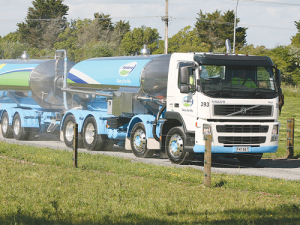Fonterra slashes forecast milk price, again
Fonterra has slashed another 50c off its milk price forecast as global milk flows shows no sign of easing.
 Fonterra’s milk collection across New Zealand for the four months to September is 3% behind the same period last season.
Fonterra’s milk collection across New Zealand for the four months to September is 3% behind the same period last season.
Fonterra’s milk collection across New Zealand for the four months to September 30 reached 297 million kgMS, 3% behind the same period last season, Fonterra says in its latest update.
September milk collection was 175 million kgMS, 2% lower than September last season.
As a result, the cooperative’s forecast offer volumes on GlobalDairyTrade over the next 12 months for New Zealand products has been decreased by 11,199 MT. Including this latest decrease, Fonterra has reduced GDT offer volumes since August 1, 2016 by 55,481 MT.
North Island milk collection in September reached 110 million kgMS, 5% behind September last season.
“Unfavourable weather conditions continue to impact production across most dairying regions. High levels of rainfall in October have made conditions difficult across many regions, but most noticeably in the central region where daily production is down around 14% compared to last year,” the update says.
South Island milk collection in September reached 64 million kgMS, 3% above September last season. Initial October collections indicate milk volumes in the South Island have begun to decline and may fall below last season, it says.
Fonterra’s milk collection across Australia in September, was 12 million kgMS, 1 million kgMS lower than September last season.
“New season milk collection has been heavily impacted by unfavourable pasture conditions through winter and early spring. While we have new farmer suppliers moving to Fonterra, this increase in supply has been offset by the challenging conditions, with record rainfall seen in some regions,” the update says.
Legal controls on the movement of fruits and vegetables are now in place in Auckland’s Mt Roskill suburb, says Biosecurity New Zealand Commissioner North Mike Inglis.
Arable growers worried that some weeds in their crops may have developed herbicide resistance can now get the suspected plants tested for free.
Fruit growers and exporters are worried following the discovery of a male Queensland fruit fly in Auckland this week.
Dairy prices have jumped in the overnight Global Dairy Trade (GDT) auction, breaking a five-month negative streak.
Alliance Group chief executive Willie Wiese is leaving the company after three years in the role.
A booklet produced in 2025 by the Rotoiti 15 trust, Department of Conservation and Scion – now part of the Bioeconomy Science Institute – aims to help people identify insect pests and diseases.
President Donald Trump’s decision to impose tariffs on imports into the US is doing good things for global trade, according…
Seen a giant cheese roll rolling along Southland’s roads?